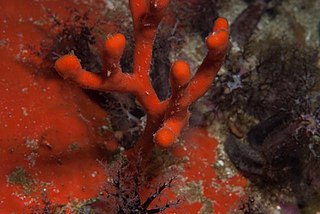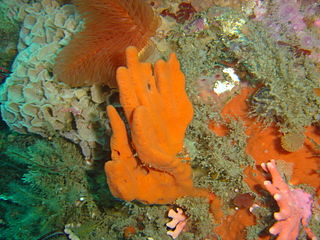The crumb-of-bread sponge is a species of sea sponge in the class Demospongiae.

The grey wall sponge is a species of sea sponge belonging to the family Ancorinidae. It is found around the coast of Southern Africa from the Northern Cape to KwaZulu-Natal. It is an endemic species.
The red encrusting sponge is a species of sea sponge. It is known only from the South African coast, on both sides of the Cape Peninsula. It is endemic to this region.

The tree sponge is a species of demosponge. It is known from the west coast of South Africa to Cape Agulhas. It is endemic to this region.
The brain sponge is a species of marine demosponge in the family Isodictyidae. This sponge is known from the west coast of South Africa to Port Elizabeth. It is endemic to this region.

The flat leaf sponge is a species of marine demosponge in the family Isodictyidae. This sponge is known from the west coast of South Africa to False Bay. It is endemic to this region.
The yellow encrusting sponge is a species of sea sponge in the family Biemnidae. This sponge is known from the west coast of South Africa to Port Elizabeth. It is endemic to this region.

Haliclona anonyma, the turret sponge or tubular fan sponge, is a species of demosponge. It is endemic to South Africa, where it occurs between the Cape Peninsula and Sodwana Bay.

Haliclona stilensis, the encrusting turret sponge, is a species of demosponge. It is known around the southern African coast, from Namibia to the South African south coast.
The black stink sponge, is a species of sea sponge in the family Irciniidae. This sponge is known around the Australian coast and around South Africa from the Cape Peninsula to Cape Agulhas.

Myxilla incrustans is a species of demosponge. It is an encrusting species and is usually yellow.
Haliclona submonilifera, or the bubble bead sponge, is a deep-water demosponge from the continental shelf and slope off south-west Africa.
Hamacantha esperoides is a species of demosponge. It is commonly known as the fibrous sponge. It occurs off the southern and western coasts of South Africa, off the coast of Namibia, and off the southeast coast of South America.
Inflatella belli, or the gooseberry sponge, is a species of demosponge that appears to be restricted to the southern hemisphere, where it is widespread. It occurs from the coast of Namibia and the Indo-pacific, down to the Subantarctic and Antarctic regions.
Mycale anisochela, the brain sponge, is a species of demosponge from South Africa and Namibia.
Polymastia bouryesnaultae, the knobbly sponge, is a small and cryptic species of demosponge from South Africa and Namibia.
Suberites dandelenae, the amorphous solid sponge, is a species of deep-sea demosponge from South Africa and Namibia.
Penares sphaera, the crater sponge, is a deep sea demosponge from southern Africa.
Tetilla capillosa, the furry sponge, is a species of demosponge from southern Africa.
Rossella antarctica is a relatively small species of glass sponge. It is widely distributed in the southern hemisphere, particularly in the Antarctic and sub-Antarctic regions.






